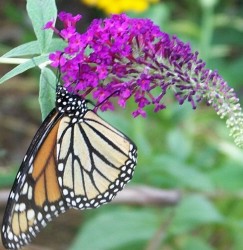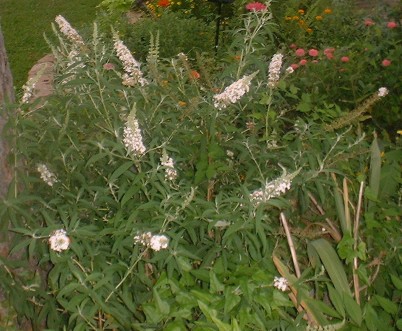|
Gardens Ablaze |
||
|
|
Butterfly
Bush (Buddleia)
|
|
|
Detailed Shrub & Hedge Plant Profiles Site Map
Home
|
I personally didn't try Butterfly Bush until a few years ago because the plants at the garden store were kind of beat-up looking with few blooms and were actually quite pricey. Finally one day in my travels I found some bare-root specimens that were a buck apiece so I said what the heck and bought white and purple. I put them in pots where they languished for the entire summer, and finally during fall clean-up I made room for them and planted them in the ground. With the warm spring, they barged out of the ground and grew quickly to about 5 feet.
One thing that I noticed when my plants were in their first couple of years was that when it rained or when I turned on the sprinkler, the blooms all flopped down because they are too heavy, some all the way to the ground. As one might imagine, this compromised the overall look of the plant fairly significantly. However, as the plant gets bigger (and it does get BIG - 6 feet or more), this becomes a non-issue, so just be patient. Butterfly bushes produce blooms on new wood, and as such can be pruned pretty much whenever necessary within reason. Obviously, don't prune a stem with buds on it but any branches that have finished flowering are fair game. Prune hard in early spring when the plant starts looking vigorous but before any buds appear, and then give a light pruning of new branches in mid summer, if necessary. The plant prefers full sun and average soil, with good drainage. Once established, Butterfly Bush is fairly drought tolerant, but don't let it get so dry that it is stressed. The plant will die to the ground in winter in northern climates and will be late to re-emerge, so don't forget where it is and inadvertently overplant it with something else in the spring. Uses are many for the Butterfly Bush in the home landscape. With flower colors including purple, blue, yellow, white, and pink, there is a Butterfly Bush for every type of home scenario except those with too much shade. It's an obvious choice for bee and butterfly gardens, and is often used as the centerpiece in these gardens. Mature specimens make a nice hedge plant, or back of border plant, and grouped together, Butterfly Bushes make sensational focal points, but again, they die all the way back in winter so don't forget to plan for that. As they are bee magnets, it is probably not a good idea to plant them right at an entryway for obvious reasons. Fertilize Butterfly Bushes in early spring using a balanced fertilizer for flowering plants. If necessary, fertilize once more in mid summer to keep the plant healthy. Propagation for Butterfly Bushes can be done from softwood cuttings in the spring, before the plant becomes too woody. Try to retain at least two sets of leaves, pot the cuttings in good potting soil, and keep moist and out of direct sunlight until rooted. I have had good luck with softwood cuttings, so if your first attempt fails, try again because it is the best way to make new plants. Finally, Butterfly Bush blooms make good cut flowers for arrangements. Make sure you cut them when about half the flowers have bloomed but before the first and lowest flowers start to fade.
Custom Search
|
|
|
Gardens Ablaze |
||
 If
you are looking for a neat, tidy flowering shrub, Butterfly Bush really
isn't the plant for you. However, if you can get past its fairly scraggly
overall appearance and appreciate the large, profuse, colorful, fragrant
blooms that are bee and butterfly magnets, then you might want to give it
a try.
If
you are looking for a neat, tidy flowering shrub, Butterfly Bush really
isn't the plant for you. However, if you can get past its fairly scraggly
overall appearance and appreciate the large, profuse, colorful, fragrant
blooms that are bee and butterfly magnets, then you might want to give it
a try.  Butterfly
bush flowers are big at a foot or more in length, especially the first flowers
of the season. They are fat on the bottom and taper gracefully at
the ends, much like lilacs. The plant will take a couple of years
to reach full rounded form, but rest assured, it will eventually.
It helps to cut the plant back severely in late fall or early spring when
it is dormant (more on this below). It will grow bigger and
better every year. Blooms occur on every stem, with somewhat
smaller blooms on side stems. Removing spent blooms with pruners is
recommended to keep the plant producing more flowers. The plant grows
like a weed, so this is a good way to keep it sorta kinda within bounds
too.
Butterfly
bush flowers are big at a foot or more in length, especially the first flowers
of the season. They are fat on the bottom and taper gracefully at
the ends, much like lilacs. The plant will take a couple of years
to reach full rounded form, but rest assured, it will eventually.
It helps to cut the plant back severely in late fall or early spring when
it is dormant (more on this below). It will grow bigger and
better every year. Blooms occur on every stem, with somewhat
smaller blooms on side stems. Removing spent blooms with pruners is
recommended to keep the plant producing more flowers. The plant grows
like a weed, so this is a good way to keep it sorta kinda within bounds
too.